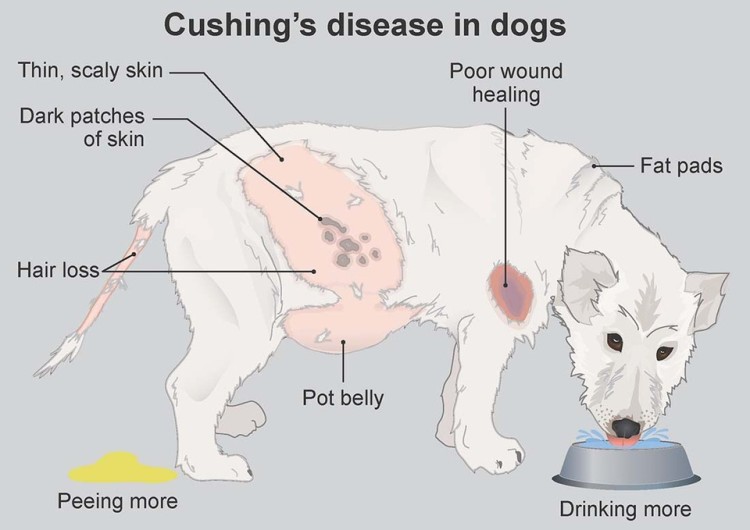Cushing’s disease, also known as Cushing’s syndrome, hyperadrenocorticism, or hypercortisolism, is a condition that usually affects older dogs. The disease happens when your pup’s body produces too much cortisol. This is a steroid hormone that your body produces naturally. This hormone helps dogs control their weight, respond to stress, keep blood sugar levels stable, and fight infections, but too much of it can cause health issues.
Because of the complex diagnostic testing required, Cushing’s disease is underdiagnosed and can be very serious if left untreated.
In this post, you’ll learn everything about Cushing’s disease in dogs—from symptoms and types to treatment and recovery.
Pro tip: While vet bills can be extremely high for serious illnesses and surgeries, your stress levels don’t have to follow suit. Claims for Cushing’s Disease treatment can reach thousands of dollars, but with the right dog insurance policy, you could see those bills be covered up to 90%!
Types of Cushing’s Disease
There are three major types of Cushing’s disease that can affect dogs, each with a different cause:
Pituitary gland tumor The tumor of the pituitary gland is the most common cause of Cushing's disease (about 85% to 90% of cases). The tumor causes the pituitary gland to secrete excess ACTH, a hormone that triggers the adrenal glands to overproduce cortisol. In general, if the adrenal glands’ activity can be controlled by taking prescribed medication, many canines with pituitary Cushing's can live normally for years. However, in about 15% of cases, the tumor will grow and affect the brain, resulting in neurological symptoms and giving your furry companion a less favorable prognosis.
Adrenal gland tumor Adrenal gland tumors can also cause Cushing's disease. If the tumor is benign and can be removed with a surgical procedure, the disease will be cured. However, if it’s a malignant tumor, surgery might help only temporarily.
Iatrogenic Cushing's disease This type of Cushing’s disease is caused when a dog has taken steroids for a long time. For instance, administering excessive amounts of dexamethasone or prednisone for a prolonged period of time, although given for a legitimate medical reason, can cause Cushing’s disease. This form of the disease usually resolves after the steroids are stopped.
Which Breeds Are at Risk?
Any breed of dog can develop Cushing’s disease. Certain dog breeds are at a higher risk of developing Cushing’s disease, including:
- Australian Shepherd
- Boxer
- Beagle
- Boston Terrier
- Cocker Spaniel
- Dandie Dinmont
- Dachshund
- German Shepherd
- Labrador Retriever
- Maltese
- Poodle
- Staffordshire Terrier
- Yorkshire Terrier
Almost all affected dogs are older than 8 years when the condition develops.

Symptoms of Cushing’s Disease in Dogs
There’s a number of symptoms that a pup with Cushing’s disease can develop. Here are some of the most common ones:
- Increased appetite
- Increased thirst
- Reduced activity
- Increased urination
- Excessive panting
- Recurrent skin infections
- Hair loss
- Thin or fragile skin
- Oily skin or seborrhea
- Enlargement of the abdomen
- Blackheads
- Lethargy
- Recurrent urinary infections
- Urinary incontinence
- Sudden blindness.
How Does the Disease Affect Your Pup’s Health?
While the disease is not painful, if left untreated, it can cause a range of health issues.
About 15% of dogs with pituitary tumors develop neurologic symptoms as the tumor grows and about 10% of patients with Cushing’s will also develop diabetes.
Protein loss through the urine and high blood pressure are also quite common in dogs with this disease and can lead to kidney disease.
In addition, Cushing’s patients are at risk for fatal blood clots called pulmonary thromboembolism.
Cushing’s disease can also result in bladder stones, changes in the liver, skin infections, UTIs, and pancreatitis.
Diagnosing Cushing’s Disease
Since there is no 100% accurate method for diagnosing Cushing’s disease, your vet will probably run several different tests to see what might be causing your dog’s symptoms.
They’ll start by testing your pup’s blood and urine in order to detect UTIs, dilution, or problems with certain enzymes found in the bones and liver. If the results come back consistent with Cushing’s disease, the vet will proceed with hormone tests, such as:
-
LDDS (Low dose dexamethasone suppression) test, which looks at how your pet’s body reacts to dexamethasone, a man-made version of cortisol and
-
ACTH stimulation test, which shows how well the adrenal glands respond to the ACTH hormone that usually triggers them to produce cortisol.
If your vet suspects that your dog might have Cushing’s disease, they might also do an ultrasound of the pup’s abdomen to check for adrenal gland tumors.
 Image source: American Kennel Club
Image source: American Kennel Club
Treatment for Cushing's Disease in Dogs
The treatment of this disease largely depends on the cause.
If the condition is caused by excessive use of steroids, the steroids should be tapered down or stopped altogether. However, this might result in a relapse of the primary disease the steroids were originally prescribed to treat.
Pituitary-dependent Cushing’s isn’t curable but can be managed and your pup can have a normal life for years. Most pets with Cushing’s disease caused by a pituitary gland tumor can be treated with medications. The two most commonly used options are Lysodren (mitotane) and Vetoryl (trilostane) which are given lifelong.
Make sure to follow your vet’s treatment plan for your dog’s specific condition because the success of these treatments often depends on regular and consistent administration of the medication. Most canines can be successfully treated with few side effects. However, the patient should be monitored using clinical signs and regular blood tests in order to ensure proper dosage is administered and that there are no unwanted complications.
In some cases, radiation therapy is recommended if the tumor is larger and is causing neurologic symptoms. Radiation treatment for pituitary Cushing's syndrome can improve or eliminate neurological symptoms, especially when started early.
Dogs with adrenal gland tumors usually require surgery. If the surgery is successful and the tumor is not malignant, there’s a good chance that your furry companion will recover completely.
What’s the Treatment Cost for Cushing’s Disease?
The cost of diagnosis will depend on the underlying type of Cushing’s disease and any concurrent diseases that may mask certain signs. Typically, a complete diagnosis costs between $500 and $1,500.
The treatment can cost from $50 to $200 a month, depending on the pup’s response to the selected medication. Frequent bloodwork will also be needed to confirm the patient's response to the therapy, which might also affect the overall cost.
The cost of surgery can be quite high due to the need to see a certified specialist. These procedures are estimated at $2,500 - $10,000.
Pet owners can’t predict when surgery might be needed. While your vet will guide you through the surgical process, you’ll also need someone to help you with the financial aspects. A comprehensive pet insurance plan will help pick up the tab and allow you to focus on your dog’s full recovery.
What’s the Prognosis?
As mentioned earlier, Cushing’s disease cannot be cured in most cases but it can be managed so that your pup lives a good-quality life for years to come. The sooner you start treatment, the sooner your pooch will begin to recover.
According to the American Kennel Club, the average survival time for dogs with Cushing’s disease is about 2 years and only 10% of patients live longer than 4 years. However, this doesn’t mean that the disease causes death. Because Cushing’s is usually diagnosed in senior pets, most of them die of unrelated causes caused by aging.
In Conclusion
Cushing’s disease is a serious condition that can be difficult to diagnose. That’s why keeping an eye on your canine companion, especially as they get older, for signs of anything out of the ordinary is very important. Make sure to schedule regular vet visits and always consult your vet if you notice anything unusual regarding your pet’s health.
